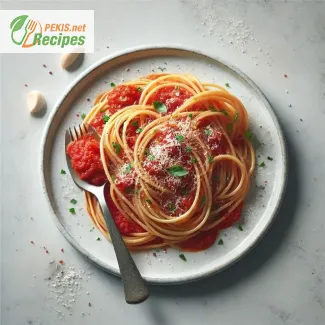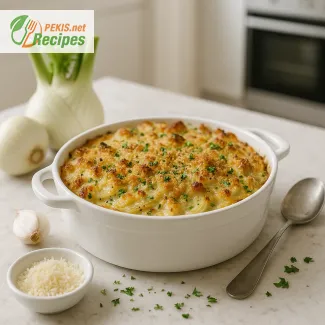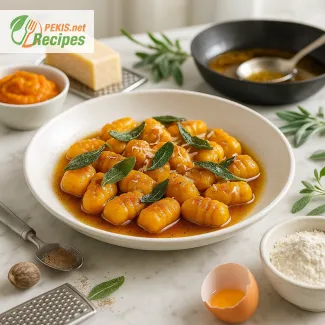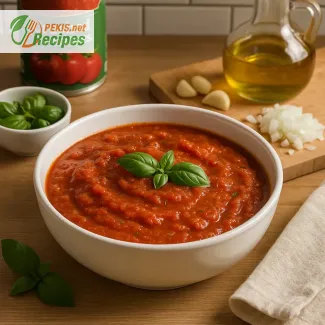
Spaghetti with Tomato Sauce and Garlic is an enduring classic in the culinary world, a dish beloved for its simplicity and rich flavors that celebrate the essence of Italian cuisine. This dish’s beauty lies in its use of high-quality ingredients, minimal preparation, and a harmonious balance between the sweet and slightly acidic notes of ripe tomatoes and the intense, aromatic depth of garlic. Each bite transports you to the heart of the Mediterranean, capturing the flavors and warmth of a true Italian kitchen.
The foundation of this dish is a velvety tomato sauce, prepared with care to preserve the freshness and vibrancy of sun-ripened tomatoes. Whether you choose San Marzano tomatoes for their natural sweetness or opt for vine-ripened local varieties, the key is to select tomatoes that are full of flavor and free from additives. Slow cooking brings out the tomatoes’ natural sweetness, allowing them to release their juices and intensify in flavor. This technique creates a sauce that is simultaneously rich, light, and bursting with a deep, fresh tomato taste.
Garlic plays a fundamental role, infusing the sauce with an unmistakable aroma and a gentle warmth. Gently sautéing garlic in extra virgin olive oil is a crucial step that allows the garlic to soften and release its essential oils. This initial step is the cornerstone of a great tomato and garlic sauce, as it builds a base of flavor that complements the acidity of the tomatoes without overpowering them. The careful handling of garlic, ensuring it reaches a golden hue without browning too much, is essential; browned garlic can become bitter and disrupt the sauce’s delicate balance.
To elevate this simple recipe, fresh basil leaves are often added at the end of cooking, enhancing the sauce with a fragrant, slightly peppery note. Basil not only contributes to the dish’s flavor profile but also reinforces its Mediterranean character. The bright green basil against the vibrant red sauce is a visual celebration, bringing a touch of summer to the plate and capturing the fresh, earthy qualities that are so integral to Italian cuisine.
Perfectly cooked spaghetti is vital to bring out the best in this dish. Cooking pasta to an "al dente" texture, where it retains a slight firmness, allows the noodles to better absorb the sauce without becoming too soft or mushy. To achieve this, it’s important to follow a few key steps: boiling the pasta in well-salted water and reserving a small amount of the pasta cooking water. This reserved water is rich in starch, which can be added to the sauce at the end to create a creamy, cohesive texture, ensuring the sauce clings beautifully to each strand of spaghetti.
A finishing touch of Parmesan or Pecorino cheese offers a savory note that pairs exceptionally well with tomato-based sauces. The addition of freshly grated cheese not only deepens the umami flavor but also adds a creamy richness that rounds off the dish. For those who prefer a dairy-free option, a sprinkle of nutritional yeast provides a similar nuttiness and works beautifully in vegan adaptations of this recipe.
For a touch of personalization, some may choose to add a hint of crushed red pepper flakes or a pinch of Italian herbs such as oregano or thyme, which infuse the sauce with additional layers of flavor. Although not strictly traditional, these additions can bring a subtle heat or earthiness, enhancing the dish’s complexity and making it uniquely your own.
Spaghetti with tomato sauce and garlic is more than just a meal; it is an experience that captures the artistry and soul of Italian cooking. It is a timeless recipe that appeals to all palates, from those seeking comfort food to those exploring gourmet cuisine. Its versatility allows it to be a standalone dish or a base for more elaborate meals, making it a staple in households worldwide. Whether you’re preparing it as a quick weeknight dinner or a centerpiece for a special gathering, this dish will always deliver satisfaction and flavor with minimal effort.
This iconic pasta dish is also a nutritional powerhouse. The tomatoes are packed with antioxidants like lycopene, which offers numerous health benefits, including supporting heart health and reducing inflammation. Garlic, known for its anti-inflammatory and antimicrobial properties, adds a health boost to this dish, making it both a delicious and nourishing choice.
In the world of pasta, spaghetti with tomato sauce and garlic is a dish that transcends trends and generations, bringing people together around a table to share in its comforting, familiar flavors. It’s a meal that’s easy to prepare yet sophisticated enough to serve to guests, embodying the concept that the best dishes are often the simplest, allowing quality ingredients to shine.
As you twirl each forkful, the aroma of garlic and fresh tomatoes lingers, and you experience the culmination of culinary tradition and modern simplicity. There’s a reason this dish has become an international favorite, representing not just the flavors but the spirit of Italy itself. For those who cherish the joy of cooking and eating, spaghetti with tomato sauce and garlic will always be more than a recipe—it’s a taste of home, a reminder of tradition, and a celebration of flavor in its purest form.
- Prepare the Spaghetti: In a large pot, bring water to a boil. Once boiling, add salt and spaghetti. Cook the spaghetti until it is “al dente” (about 8–10 minutes), then drain, reserving about 100 ml (½ cup) of the pasta cooking water.
- Make the Tomato Sauce: While the spaghetti is cooking, heat the olive oil in a large pan over medium heat. Add the minced garlic and sauté gently for about 1 minute until it becomes golden (avoid browning to prevent bitterness).
- Add the Tomatoes: Add the tomatoes to the pan with the garlic. If using canned tomatoes, crush them roughly before adding. Stir occasionally, allowing the tomatoes to break down. Add a pinch of sugar if the sauce tastes too acidic.
- Reduce and Season the Sauce: After about 15 minutes of simmering, season the sauce with salt and black pepper. Let it cook for another 10–15 minutes to thicken and deepen in flavor.
- Add Fresh Basil: Towards the end of cooking, add the basil leaves and stir them into the sauce. If the sauce seems too thick, add a few tablespoons of the reserved pasta cooking water.
- Combine the Spaghetti and Sauce: When the sauce is ready, add the cooked spaghetti to the pan and gently toss to coat the pasta evenly in the sauce.
- Serve: Plate the spaghetti with tomato sauce and garlic. Top with grated Parmesan or Pecorino cheese and garnish with fresh parsley, if desired. Serve hot.
Enhancing the flavors of spaghetti with tomato sauce and garlic is a rewarding experience that allows for subtle yet impactful modifications. Each element of this dish, from the tomatoes to the garlic and spaghetti, contributes to the overall taste and texture, creating a harmonious balance. While this recipe is already well-loved for its simplicity, you can take it to new heights with these professional tips and variations.
1. Choosing the Right Tomatoes
The heart of any great tomato sauce lies in the quality of the tomatoes. For an authentic Italian taste, San Marzano tomatoes are highly recommended due to their natural sweetness and low acidity. If fresh tomatoes are used, they should be ripe and vibrant red. Canned plum tomatoes are a convenient alternative, but always choose varieties without added ingredients to maintain a pure, fresh taste.
Tip: For fresh tomatoes, peel and deseed them before cooking. This can be done by blanching them briefly in boiling water and then transferring them to an ice bath. Removing the skin and seeds reduces bitterness, giving your sauce a smooth, refined texture.
2. Perfecting Garlic Flavor
Garlic provides a warm, aromatic foundation for this sauce, but it’s essential to handle it with care. Overcooked garlic can turn bitter and alter the taste of your sauce. Sauté the garlic gently in extra virgin olive oil on medium-low heat to prevent it from burning, allowing it to infuse the oil with a mellow, savory flavor.
Tip: For a more subtle garlic flavor, add the garlic to the oil at room temperature and let it heat up slowly. This technique allows the garlic to release its oils gradually, resulting in a softer taste that perfectly complements the acidity of the tomatoes.
3. Adjusting Acidity
Tomatoes naturally contain acidity, which can sometimes overpower the sauce. A small amount of sugar can balance this acidity, but be cautious not to add too much, as it can make the sauce taste unnatural. Some prefer a touch of carrot or onion to provide natural sweetness.
Tip: Grate a small carrot and add it to the sauce at the beginning of cooking. Carrot adds a hint of natural sweetness and depth without masking the tomato flavor.
4. Enhancing with Fresh Herbs
Basil is a classic addition that lends a sweet, peppery note to the sauce, enhancing its freshness. Adding oregano or thyme provides an earthy undertone, creating complexity. However, be sure not to overdo the herbs, as their flavors can quickly become overwhelming.
Tip: Always add fresh herbs like basil towards the end of cooking to preserve their fragrance and color. Dried herbs like oregano or thyme can be added earlier in the process, as they take longer to release their flavors.
5. Deepening Umami with Additional Ingredients
To achieve a richer, more satisfying flavor, incorporate umami elements. While Parmesan adds a subtle depth, you can also try adding Parmesan rinds while the sauce simmers, infusing it with a savory complexity. A touch of miso paste or soy sauce can provide similar umami effects in a vegan-friendly version.
Tip: If using Parmesan rinds, remove them before serving, leaving behind a deeper, nuanced flavor without altering the sauce’s texture.
6. Achieving the Perfect Sauce Consistency
The consistency of the sauce depends on personal preference. For a thicker sauce, simmer it longer, allowing the natural water in the tomatoes to evaporate. For a silkier, looser sauce, add a bit of pasta cooking water. This starchy water not only thins the sauce but also helps it adhere to the pasta for a smoother texture.
Tip: For a refined finish, blend half of the sauce and mix it back in with the chunky tomatoes. This creates a balance between a rustic and creamy texture without compromising flavor.
7. Bringing out the Natural Sweetness
Cooking the tomatoes slowly allows their natural sweetness to emerge. If you want to avoid adding sugar, this step is essential. Cooking on low heat gives the sauce time to develop a more nuanced flavor and removes any sharp acidity.
Tip: If time allows, cook the sauce on low heat for 1-2 hours, stirring occasionally. The slow cooking process develops a concentrated tomato flavor that makes the sauce richer and fuller.
8. Using Quality Olive Oil
A high-quality extra virgin olive oil is essential, as it brings both flavor and body to the sauce. This oil not only infuses the sauce with richness but also enhances the health benefits of the dish by adding healthy fats.
Tip: For the best results, drizzle a bit of extra virgin olive oil over the finished pasta before serving. This adds a fresh, fruity finish and a pleasant sheen to the dish.
9. Achieving Perfectly Cooked Pasta
Cooking spaghetti “al dente” is crucial to achieving the right texture. Pasta that is too soft can become mushy in the sauce. For the ideal al dente texture, boil the pasta in generously salted water until it still has a slight bite to it.
Tip: Reserve a small amount of pasta water before draining. This starchy water can be added to the sauce to improve its consistency and ensure it clings to the spaghetti.
10. Adding a Touch of Spice
If you enjoy a hint of heat, a dash of red pepper flakes or fresh chili pepper can add complexity without overpowering the dish. This small addition gives a subtle kick that balances well with the sweetness of the tomatoes.
Tip: Add red pepper flakes to the garlic and oil at the beginning of cooking to infuse the sauce with a mild heat. For a stronger kick, sprinkle some on top just before serving.
11. Serving Suggestions
To bring out the full flavor of the dish, add freshly grated Parmesan or Pecorino just before serving. These cheeses add a creamy, nutty flavor that complements the tomato sauce beautifully.
Tip: For a vegan-friendly alternative, try nutritional yeast. This substitute offers a similar umami flavor without dairy.
12. Personalizing with Additional Ingredients
While the classic recipe is perfect as is, you can customize it by adding ingredients like black olives, capers, or artichoke hearts. These additions provide a Mediterranean flair and can enhance the dish’s complexity.
Tip: If adding olives or capers, do so towards the end of cooking to preserve their briny flavor.
Health Benefits of Each Ingredient
Tomatoes: Rich in vitamin C, potassium, folate, and antioxidants such as lycopene, tomatoes are beneficial for skin health and immune support. Lycopene, in particular, has been shown to promote heart health and combat inflammation.
Garlic: Known for its antimicrobial and anti-inflammatory properties, garlic is an excellent addition for boosting immunity. It also contains vitamin B6, which supports cognitive health.
Olive Oil: A source of monounsaturated fats and vitamin E, olive oil supports cardiovascular health and provides antioxidants that protect cells.
Basil: Packed with vitamin K and antioxidants, basil supports bone health and adds a refreshing flavor to the sauce.
Spaghetti (whole-grain or gluten-free): Opting for whole-grain or gluten-free pasta adds fiber and B vitamins for energy support and digestive health.
Antioxidant Content and Its Benefits
- Lycopene (from tomatoes): This powerful antioxidant can help reduce the risk of certain cancers and protect the skin from UV damage.
- Vitamin E (from olive oil): This antioxidant helps protect cells from oxidative damage and supports immune function.
- Allicin (from garlic): With potent antioxidant properties, allicin helps lower cholesterol and supports heart health.
- Phenolic Compounds (from basil): These compounds have strong anti-inflammatory effects, potentially reducing the risk of chronic diseases.
These steps and insights into the healthful ingredients enable you to create a spaghetti with tomato sauce and garlic that is both delicious and nourishing. By following these tips, you can enjoy an elevated, restaurant-quality experience right in your kitchen.
This recipe contains gluten due to the spaghetti. For a gluten-free option, substitute with gluten-free pasta made from rice, corn, or quinoa.
Allergen Substitution Tips:
- Gluten-Free: Use gluten-free spaghetti.
- Dairy-Free: For a dairy-free version, omit the Parmesan or Pecorino or replace with nutritional yeast.
- Vitamin C: Provided by tomatoes, which support immune function and skin health.
- Vitamin K: Found in basil and tomatoes, essential for bone health.
- Iron: Tomatoes contribute iron, important for oxygen transport in the blood.
- Magnesium: Important for muscle relaxation and nerve function.
- Lycopene: Abundant in tomatoes, known for its antioxidant properties, which support heart health and reduce inflammation.
- Vitamin E: Present in extra virgin olive oil, contributes to skin health and acts as an antioxidant.





